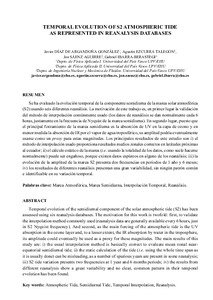Por favor, use este identificador para citar o enlazar este ítem:
http://hdl.handle.net/20.500.11765/8284
Temporal evolution of S2 atmospheric tide as represented in reanalysis databases
Registro completo de metadatos
| Campo DC | Valor | Lengua/Idioma |
|---|---|---|
| dc.contributor.author | Díaz de Argandoña, Javier | es_ES |
| dc.contributor.author | Ezcurra, Agustín | es_ES |
| dc.contributor.author | Sáenz, Jon | es_ES |
| dc.contributor.author | Ibarra Berastegi, Gabriel | es_ES |
| dc.date.accessioned | 2018-01-16T12:07:06Z | - |
| dc.date.available | 2018-01-16T12:07:06Z | - |
| dc.date.issued | 2012 | - |
| dc.identifier.citation | Rodríguez Puebla, Concepción; Ceballos Barbancho, Antonio; González Reviriego, Nube; Morán Tejeda, Enrique; Hernández Encinas, Ascensión (eds.). Cambio climático. Extremos e impactos. Madrid: Asociación Española de Climatología, 2012, p. 311-318 | es_ES |
| dc.identifier.isbn | 978-84-695-4331-3 | - |
| dc.identifier.uri | http://hdl.handle.net/20.500.11765/8284 | - |
| dc.description | Ponencia presentada en: VIII Congreso de la Asociación Española de Climatología celebrado en Salamanca entre el 25 y el 28 de septiembre de 2012. | es_ES |
| dc.description.abstract | [ES]Se ha evaluado la evolución temporal de la componente semidiurna de la marea solar atmosférica (S2) usando seis diferentes reanálisis. La motivación de este trabajo es, en primer lugar la validación del método de interpolación comúnmente usado (los datos de reanálisis se dan normalmente cada 6 horas, justamente en la frecuencia de Nyquist de la marea semidiurna). En segundo lugar, puesto que el principal forzamiento de la marea semidiurna es la absorción de UV en la capa de ozono y en menor medida la absorción de IR por el vapor de agua troposférico, su amplitud podría eventualmente usarse como un proxy para estas magnitudes. | es_ES |
| dc.description.abstract | [EN]Temporal evolution of the semidiurnal component of the solar atmospheric tide (S2) has been assessed using six reanalysis databases. The motivation for this work is twofold: first, to validate the interpolation method commonly used (reanalysis data are generally available every 6 hours, just in S2 Nyquist frequency). And second, as the main forcing of the atmospheric tide is the UV absorption in the ozone layer and, to a lesser extent, the IR absorption by water in the troposphere, its amplitude could eventually be used as a proxy for these magnitudes. | es_ES |
| dc.description.sponsorship | Authors thank the ECMWF and also the other cited institutions for granting free access to their reanalysis data. Authors thank financial support through the CGL2008-03321 (Plan Nacional I+D+i), CTP10-03 PYNATEO projects and UPV/EHU through UFI11/55 y GIU11/01 projects. | es_ES |
| dc.language.iso | eng | es_ES |
| dc.publisher | Asociación Española de Climatología | es_ES |
| dc.relation.ispartof | Publicaciones de la Asociación Española de Climatología. Serie A;8 | - |
| dc.rights | Licencia CC: Reconocimiento CC BY | es_ES |
| dc.subject | Marea atmosférica | es_ES |
| dc.subject | Marea semidiurna | es_ES |
| dc.subject | Interpolación temporal | es_ES |
| dc.subject | Semidiurnal tide | es_ES |
| dc.subject | Atmospheric tide | es_ES |
| dc.subject | Temporal interpolation | es_ES |
| dc.title | Temporal evolution of S2 atmospheric tide as represented in reanalysis databases | es_ES |
| dc.type | info:eu-repo/semantics/conferenceObject | es_ES |
| dc.rights.accessRights | info:eu-repo/semantics/openAccess | es_ES |
| Colecciones: | (2012, Salamanca). VIII Congreso AEC | |
Ficheros en este ítem:
| Fichero | Descripción | Tamaño | Formato | ||
|---|---|---|---|---|---|
| 0029_VIII-2012-J_DIAZ... | 3,52 MB | Adobe PDF |  Visualizar/Abrir |
Los ítems de Arcimis están protegidos por una Licencia Creative Commons, salvo que se indique lo contrario.





